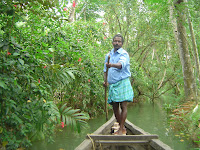In Indian rooms, classrooms and even churches, I saw elephants in the corner. The elephant sits there placidly starring at everyone with its gentle monstrosity. It carefully crosses and uncrosses its podded feet to gently touch the floor. As it often goes, no one notices or speak of the beasts lurking in corners- those looming and obvious issues. Pachyderms of injustice, hierarchy, fear and even solutions stare out to those who notice.
Elephants in India are a presence; their image inhabits temple carvings, graces bedsheets, pottery vessels, choztkys and enshrined as the hindu god Ganesh. They are bulldozers to move logs or are gilded with gold and admired in the outdoor temple festival. They walk the festival streets and people glaze over this four-podded giant tip-toing beside them as an ordinary dog out for a walk.
In India, heated discussions swirl in a tiny office while an elephant sits in the corner, when momentarily, the discussion pauses and all bronze eyes glance in the corner, for a glimpse and to make sure to not get stepped on. At the train station, trash is thrown on the tracks, and a lone 8 yr old sifts it, with the elephant staring at her through the hurrying legs of the crowd.
In America, elephants in the corner are briefly noticed as a joke that we wave at, chuckle at its rubber satellite ears, and titter at its tiny switching tail that emanates from the hulking form. We sit in our large offices, safely away from Dumbo, and read in awe of an Indian elephant who rampaged at a temple Pooram festival, killing four. A chill runs down your back as the cause of the rampage was a man who touched the tusk of an elephant, sending it off. You wonder why he wanted to touch a presence, something better left unsaid, or unnoticed. Your blue eyes dart to the corner, and sense that the tiny switching tail leads to no joke, but an issue left unchecked.
























